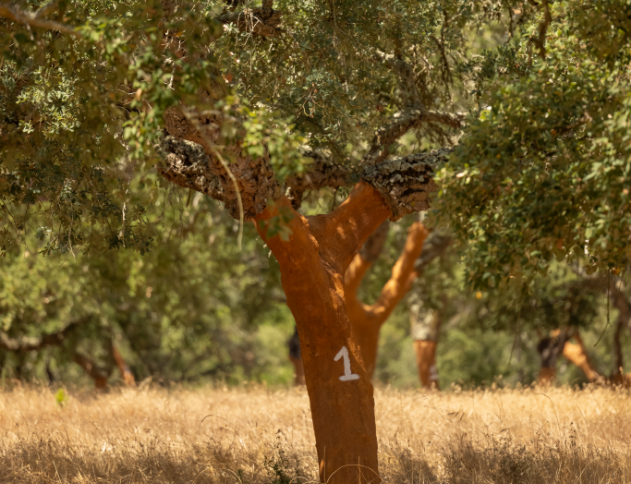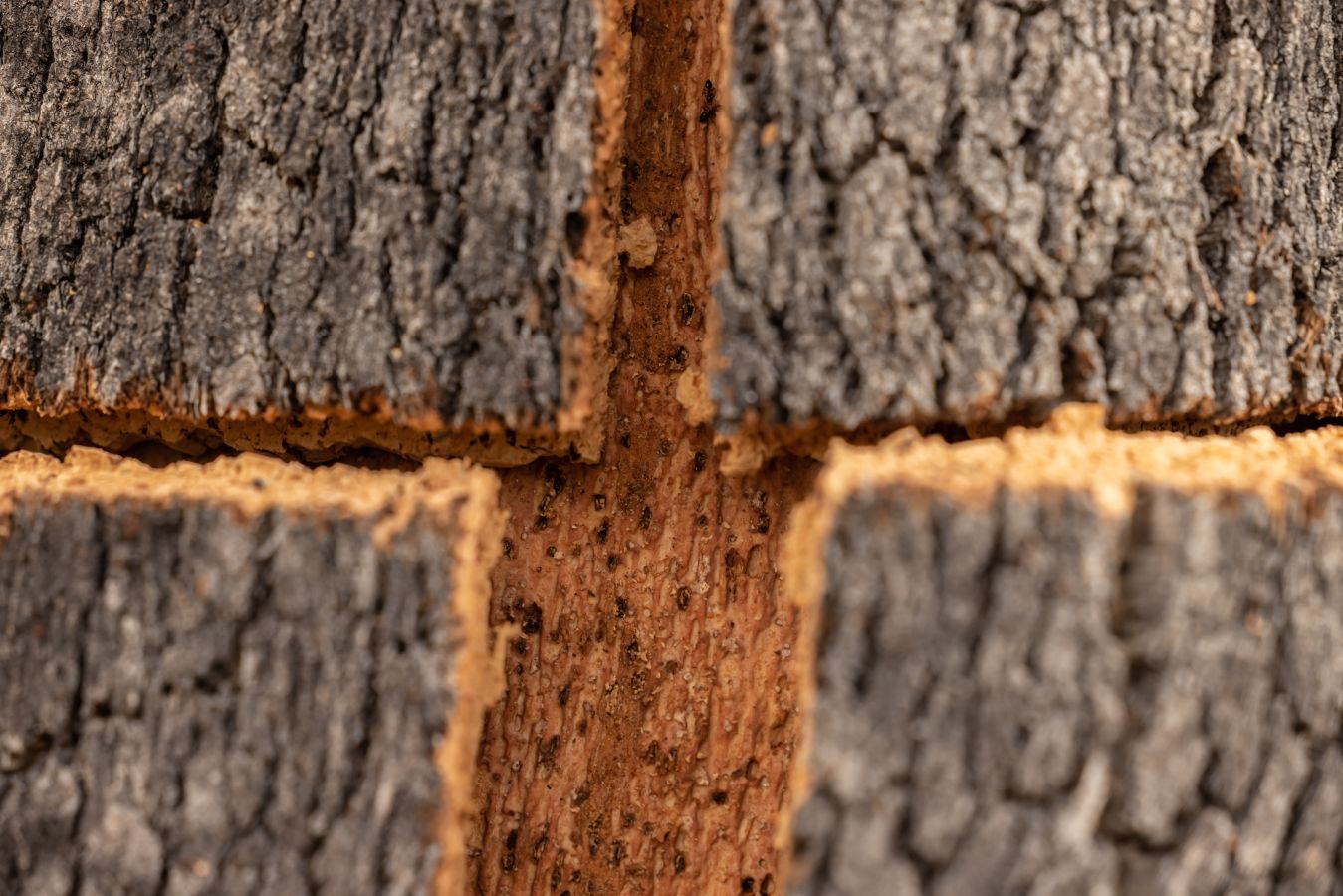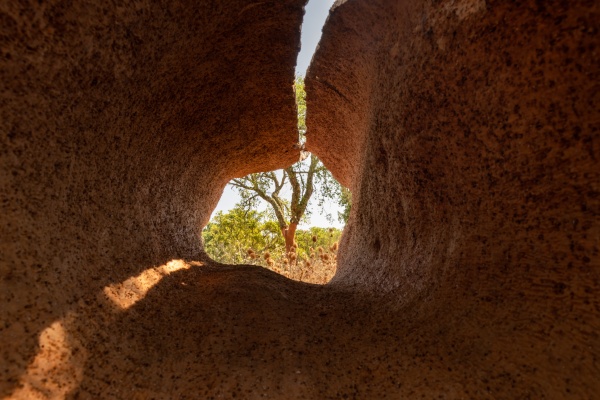“…When uncorking a bottle of a good wine or using any of the dozens of products made from natural cork, have you ever stopped to wonder where it comes from? If so, come with us to discover the Cork Oak (Quercus suber), one of the most extraordinary trees on Earth. Whether fully clothed, in its arm-thick, fissured, light grey bark, or with brick red trunks recently undressed by a once-a-decade harvest of its corky clothing, this tree has great beauty, mystery and charm. The landscapes where it occurs have the same charm, or even more to those who know how to read them …”
in Aronson J., Pereira J. S., Pauses J. (2009) “Cork Oak Woodlands on the Edge: Conservation. Adaptive Management and Restoration”, Island Press, New York
in Aronson J., Pereira J. S., Pauses J. (2009) “Cork Oak Woodlands on the Edge: Conservation. Adaptive Management and Restoration”, Island Press, New York

A very special tree
The cork oak is the only plant species capable of producing cork in a sustainable manner and with the highest quality, resulting in an industry that is unique in the world, and that is vital for the maintenance of the montado and the preservation of the flora and fauna. It is a tree with voluminous bark with suberose tissue (the cork); it has green foliage all year round, and can reach up to 10 to 15 meters in height when adult. It has good longevity and an enormous capacity for regeneration.
The cork oak is the only plant species capable of producing cork in a sustainable manner and with the highest quality, resulting in an industry that is unique in the world, and that is vital for the maintenance of the montado and the preservation of the flora and fauna. It is a tree with voluminous bark with suberose tissue (the cork); it has green foliage all year round, and can reach up to 10 to 15 meters in height when adult. It has good longevity and an enormous capacity for regeneration.
The cork oak is also known as Quercus suber L. as it belongs to the oak family, forming part of a subgroup that includes European and Asian origin species – the Cerris group. One of the most interesting characteristics of the cork oak is its homogeneous outer bark, formed by an impermeable, elastic tissue with thermal insulating properties: cork. The process of annual addition of cork rings is the result of the activity of a set of cells called the phellogen. The homogeneity of cork is due to the phellogen of the cork oak remaining active throughout the life of the tree. This is different from other trees, where the phellogen is discontinuous and has a short annual duration. The cork can be removed without damaging the tree, enabling it to be regenerated.
Nothing is wasted in the cork oak. Its fruit, the acorn, is used for propagation by the tree itself, as food for certain species of animals, and in the production of cooking oil. The leaves are used as natural fertilizer and as fodder. Firewood and charcoal are materials that result from pruning. The natural acids found in the wood of cork oak are used in beauty products and chemical products.
How is formed?

The process of annual addition of cork rings is the result of the activity of a set of stem cells – the phellogen. The homogeneity of the cork is the result of the cork oak phellogen remaining active throughout the life of the plant. The particularity of the cork oak bark is that the outer layer is composed of suberised cells, forming an elastic, waterproof, homogeneous tissue with good thermal insulation i.e. cork.

When the cork is harvested, in late spring or summer (from around the middle of May to the middle of August), it is essential that the phellogen is active and that it continues to divide; for this, the tree must been in good hydric condition, and the weather must suitable (if it is windy or raining, the cork cannot be harvested). Only under these conditions can the cork be removed without damaging the tree. After extraction, the dry phellogen underneath forms a new layer of phellogen. It is not necessary to cut the tree in order to remove the cork

More than 200 thousand tons of cork are produced worldwide, each year. In this area, Portugal and Spain have the clear leadership in terms of areas of cork oak forests, representing, together, more than three quarters of the world’s cork production. Portugal continues to lead the world in terms of the production of cork, with an average annual production of more than 100 thousand tons
|
Country |
Annual Production (tons)* |
Percentage |
|
Portugal |
85.145 |
46 |
|
Spain |
61.504 |
33 |
|
Marroco |
11.686 |
6 |
|
Algeria |
9.915 |
5 |
|
Tunisia |
6.962 |
4 |
|
Italy |
6.161 |
3 |
|
France |
5.200 |
3 |
|
Total |
186.573 |
100 |
* Source: FAO (2010) e Agro.Ges (2019)
Little known facts
The cork oak is a national heritage of Portugal. It has been legally protected since the Middle Ages, when cutting it down was prohibited. The cork oak was made the National Tree of Portugal in December 2011. This was by the unanimous decision of the Assembly of the Republic, after the presentation of a draft resolution, supported by a petition that collected more than 2,000 signatures. The importance of the role of the cork oak, which gives a lot and asks for little, has therefore been recognized and valued by the Portuguese Parliament.
To commemorate the first anniversary of the elevation of the status of the cork oak to National Tree of Portugal, a specimen of the tree was planted in the gardens of the Assembly of the Republic – sponsored by Portuguese novelist José Luís Peixoto. To celebrate the third anniversary, three cork oaks were planted in a garden in Lourosa/Santa Maria de Lamas, this time sponsored by fashion photographer Frederico Martins
The cork oak is considered by the WWF to be one of the most endangered and emblematic species of Portugal.
In 2018, the cork oak tree known has “Whistler Tree”, that is in Águas de Moura, Palmela, has been elected the European Tree of the Year.
Protection of the Species
The national and regional legislation in Portugal protects the montados and prohibits the unauthorised felling of trees. Cork oak trees can only be cut down if they are dead or diseased, and even then, only with the written permission of the authorities.
The legislation imposes heavy fines for damage or improper management of the trees, and lays down strict rules regulating the harvesting and maintenance of the trees. These rules state, for example, that a young tree can only be stripped when it reaches near 25 years of age and it is at least 70 cm in diameter and 130 cm in height.
The legislation imposes heavy fines for damage or improper management of the trees, and lays down strict rules regulating the harvesting and maintenance of the trees. These rules state, for example, that a young tree can only be stripped when it reaches near 25 years of age and it is at least 70 cm in diameter and 130 cm in height.
Another rule is that the cork bark cannot be stripped above a height equal to twice the perimeter of the trunk in the first stripping, or not more than three times, for a mature tree in full production. It is also not permitted to remove cork from the branches of the trees, if these are less than 70 cm in diameter. In all cases, it is absolutely forbidden to harvest the cork at intervals of less than nine years (even if an individual tree is ready to be harvested before this period). There are laws governing the tilling of the soil around the trees, the correct pruning, and establishing fines for neglect and mismanagement.
